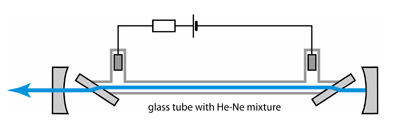Optipedia • SPIE Press books opened for your reference.
Helium-Neon Lasers
Excerpt from Field Guide to Lasers
A helium-neon laser is based on a tube filled with a mixture of helium and neon gas. An electrical glow discharge excites helium atoms, which transfer their energy to neon atoms during the collisions. Neon has several laser transitions, the most popular being in the red spectral region at 632.8 nm, with others at 1.15 µm, 543.5 nm (green), 594 nm (yellow), 612 nm (orange), and 3.39 µm. A particular wavelength is selected by using suitable resonator mirrors. Due to the low laser gain, the resonator loss has to be small, typically below 1%.

The above setup is based on a glass tube that could be used with different mirror sets and is terminated with Brewster windows. Low-cost devices often have internal mirrors that cannot be exchanged.
Typical HeNe lasers have a gas cell with a length of roughly 20 cm, and they can generate a few milliwatts of output power in continuous-wave operation at 632.8 nm, using several watts of electrical power. The beam quality is usually excellent.
Helium-neon lasers, particularly the standard devices operating at 632.8 nm, are often used for alignment purposes and are competing with laser diodes, which are more compact and efficient but have less convenient beam properties.
R. Paschotta, Field Guide to Lasers, SPIE Press, Bellingham, WA (2008).
View SPIE terms of use.

